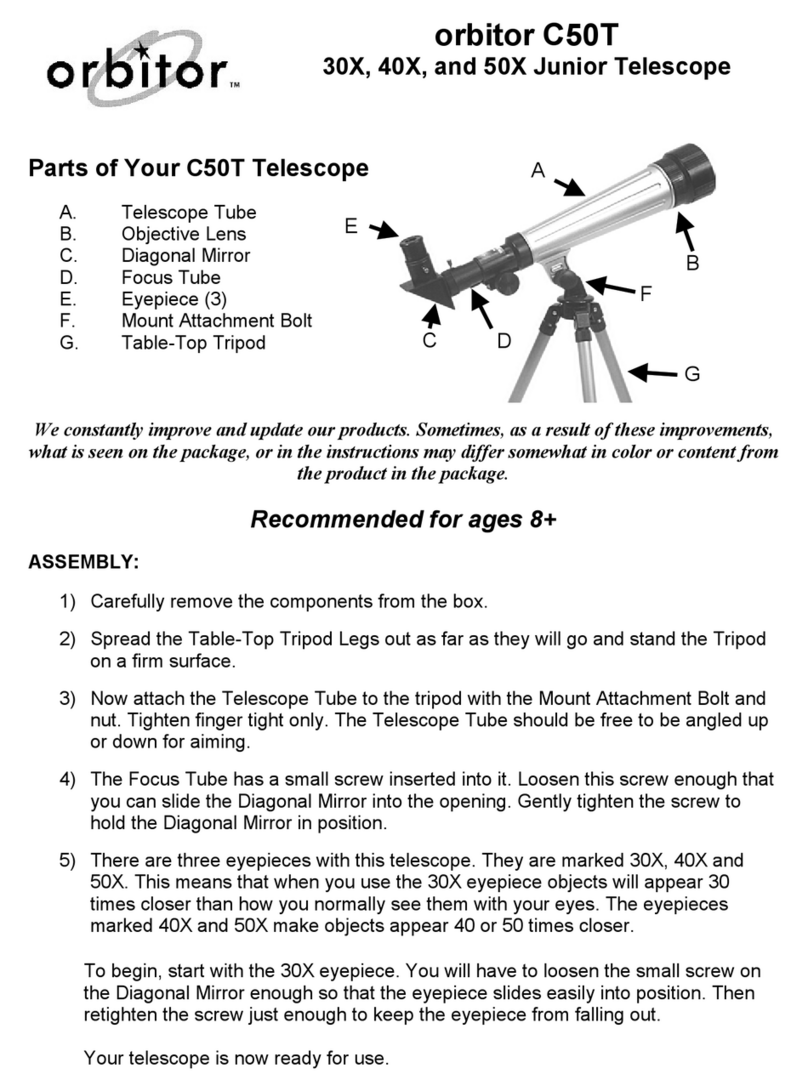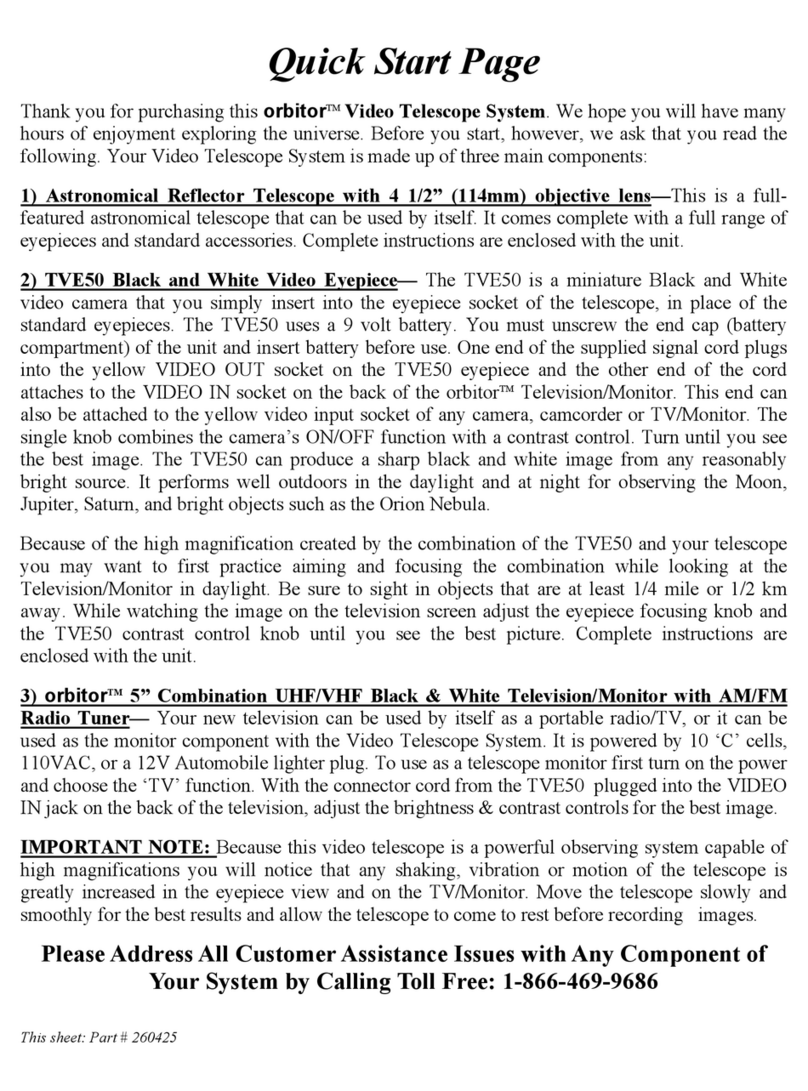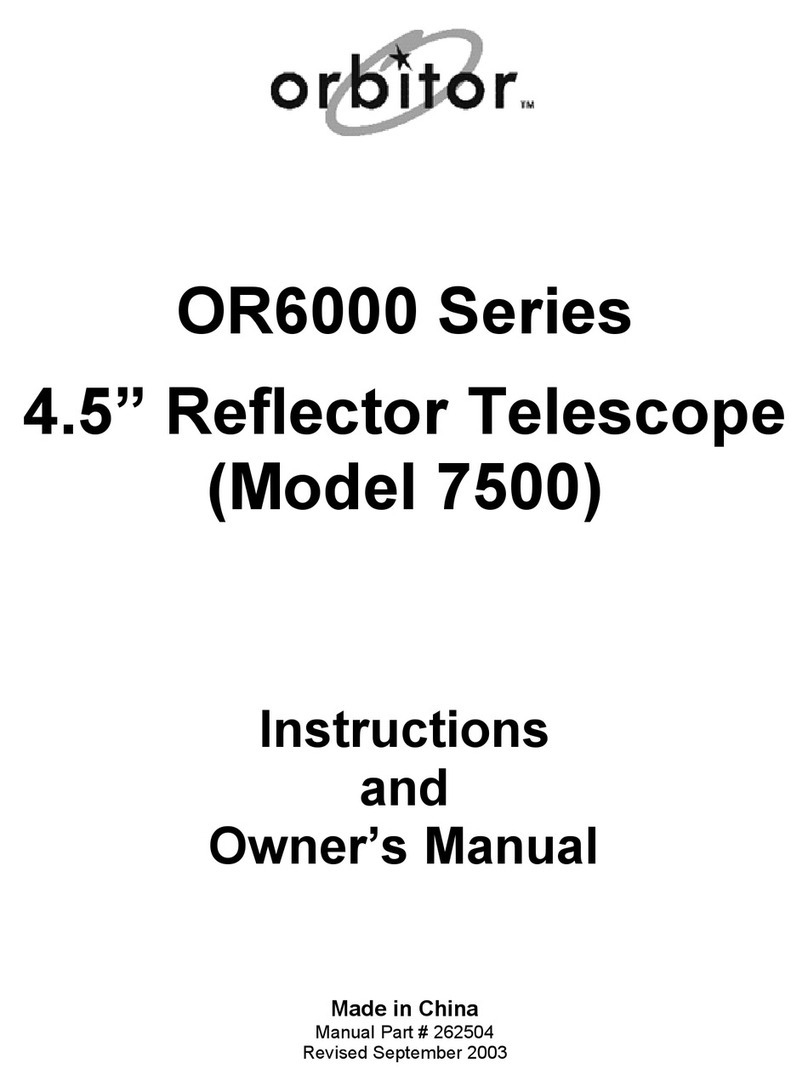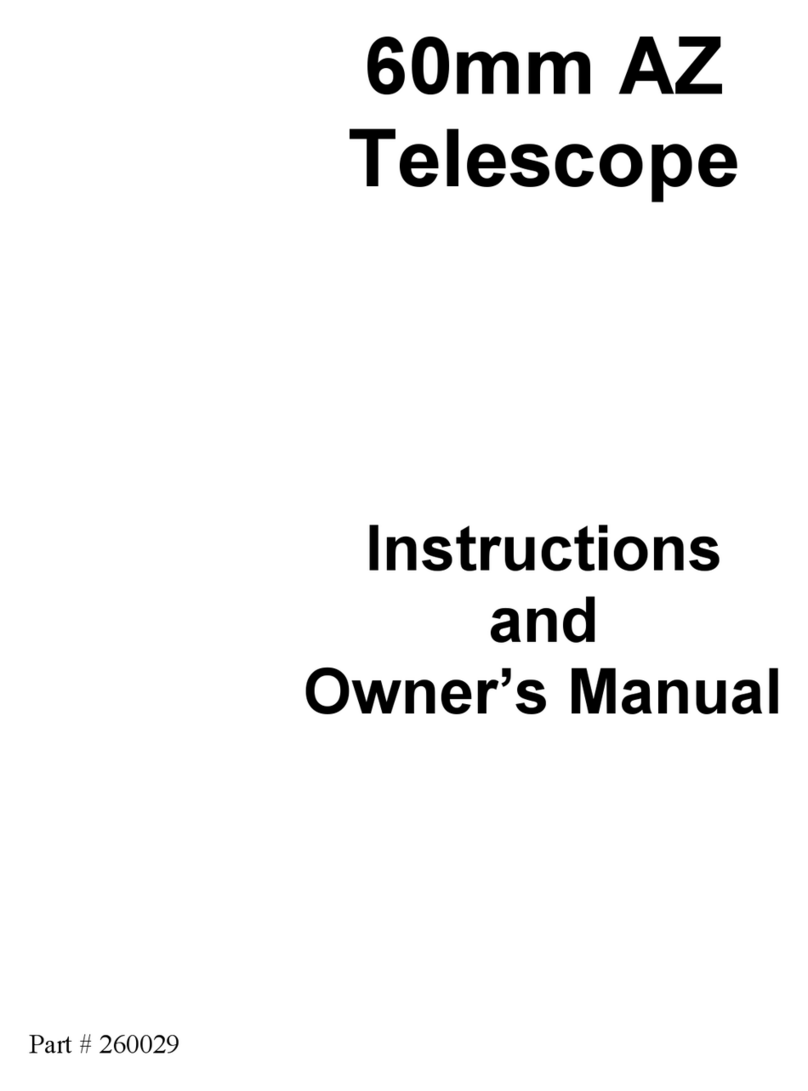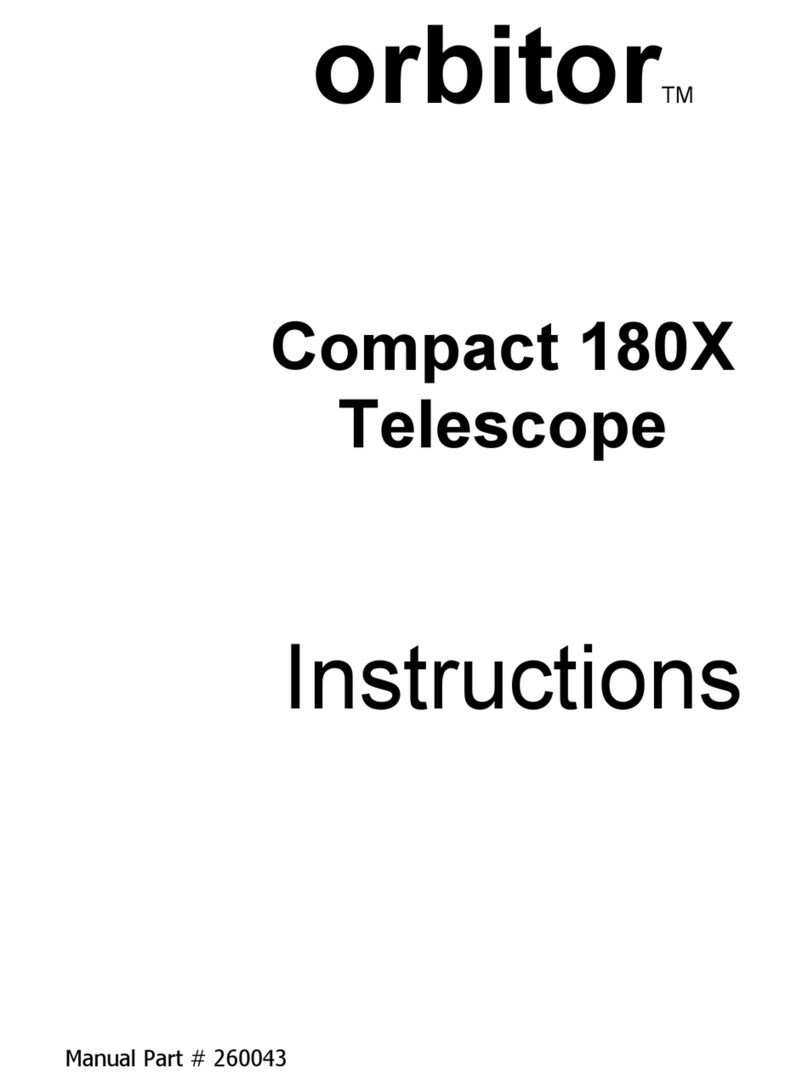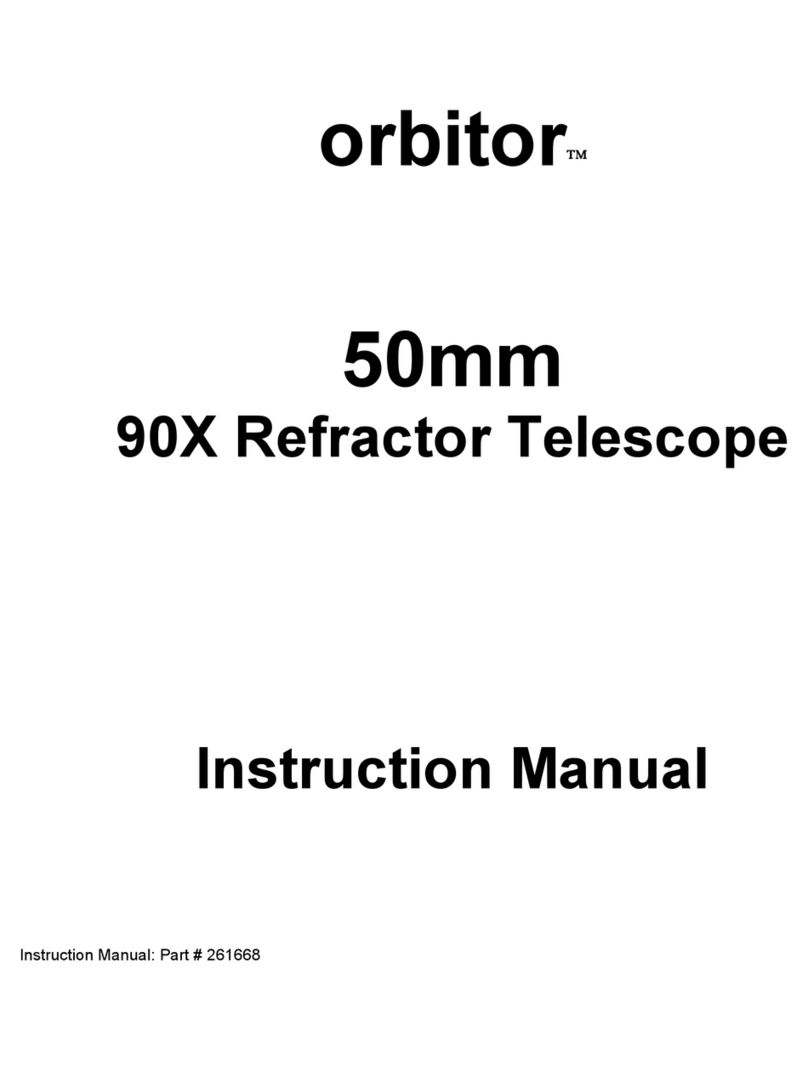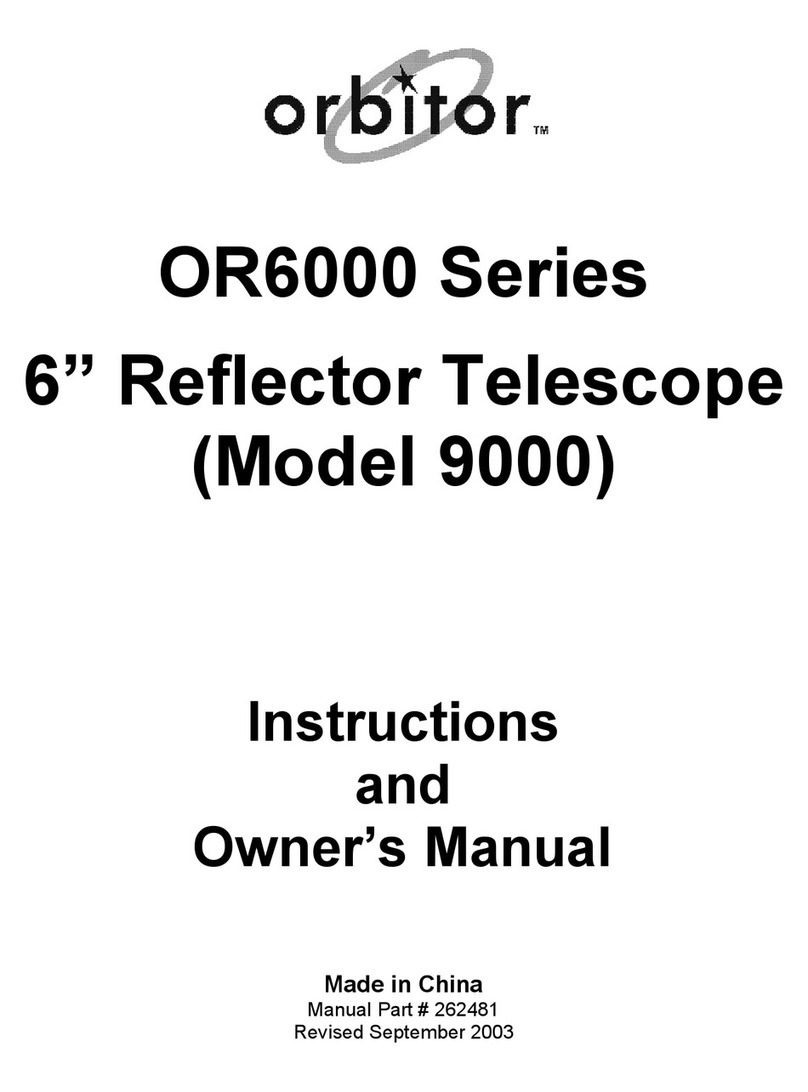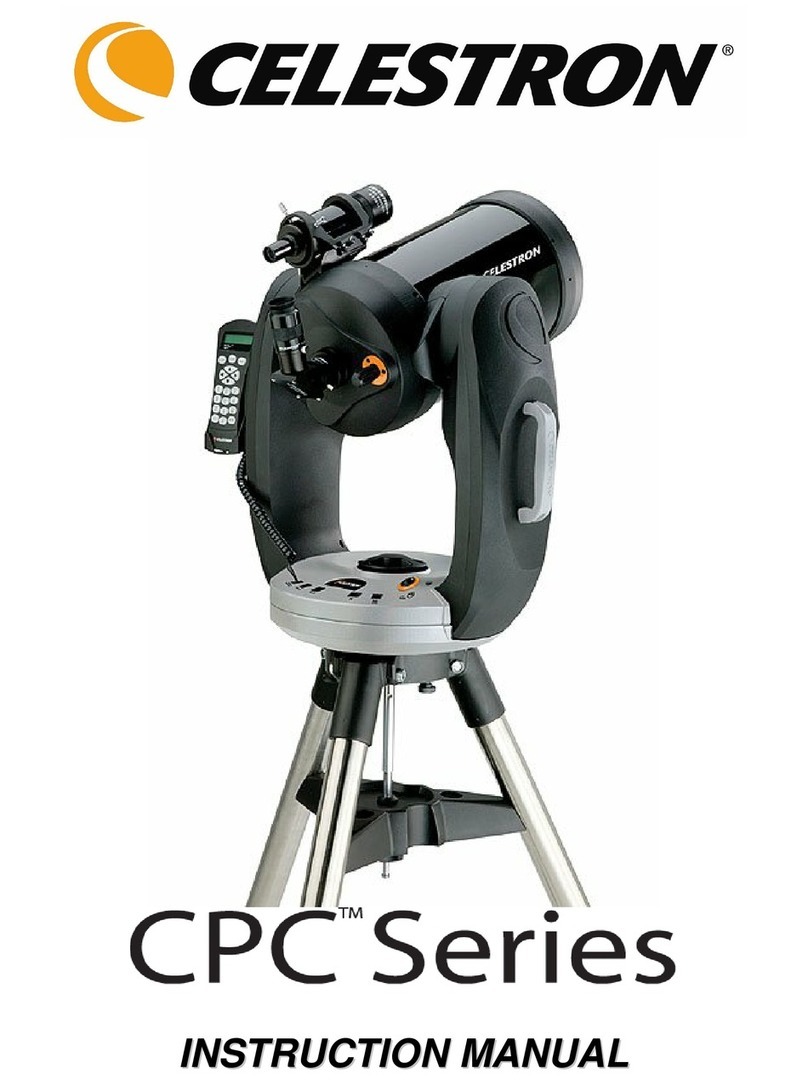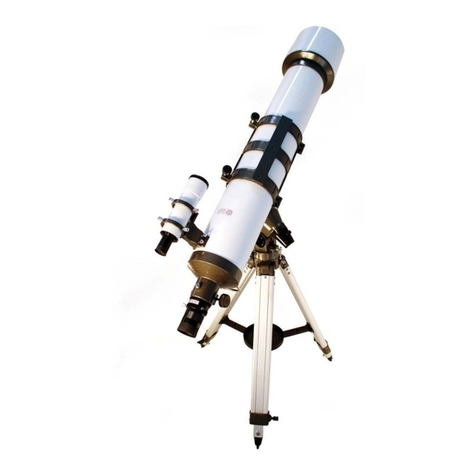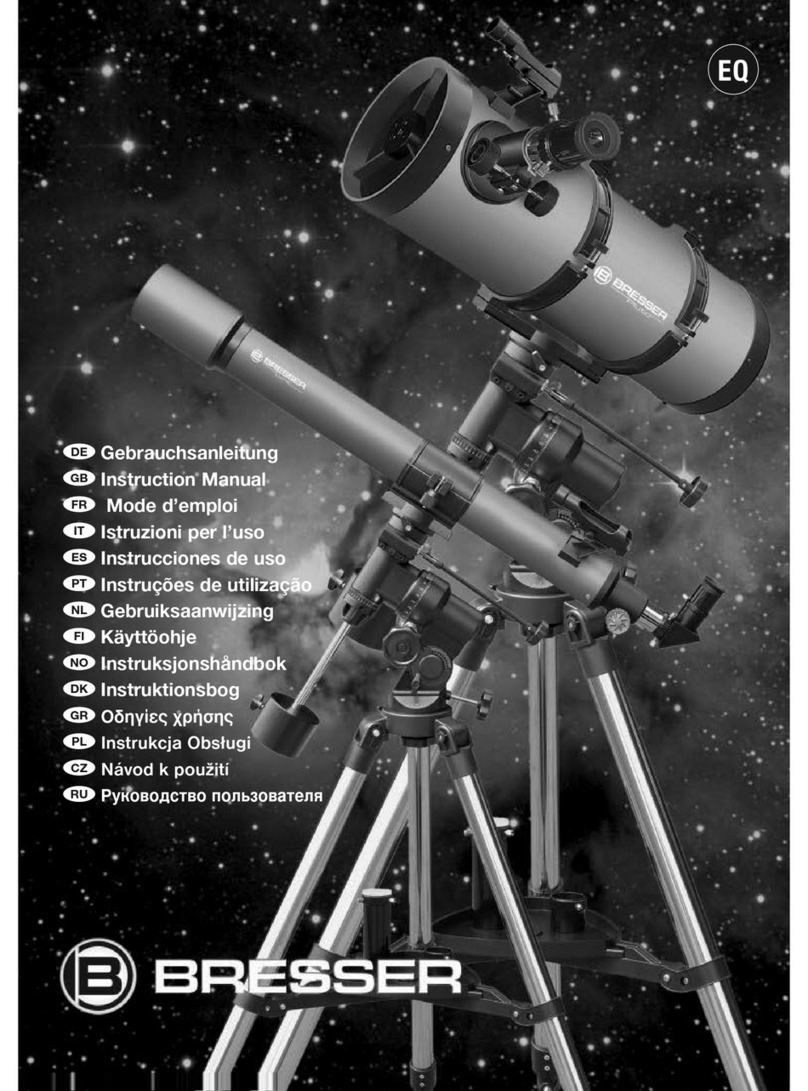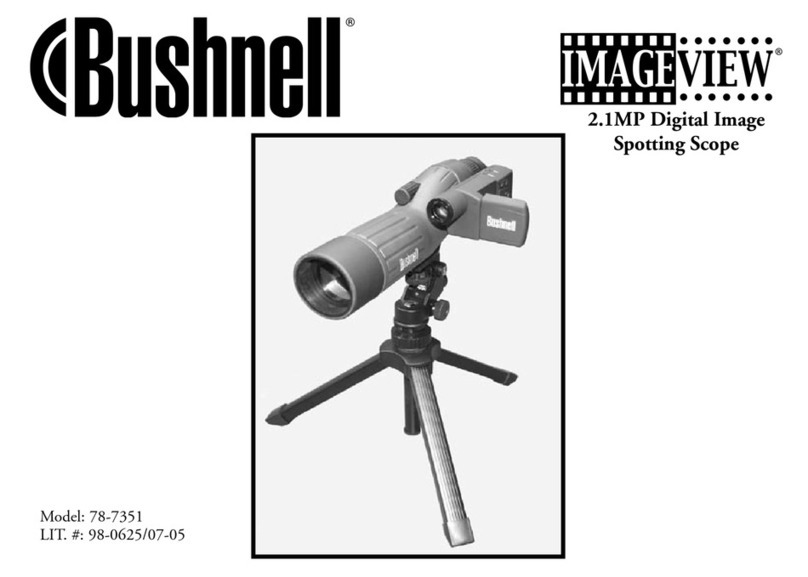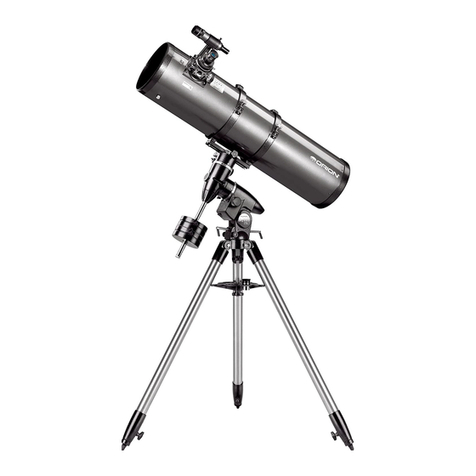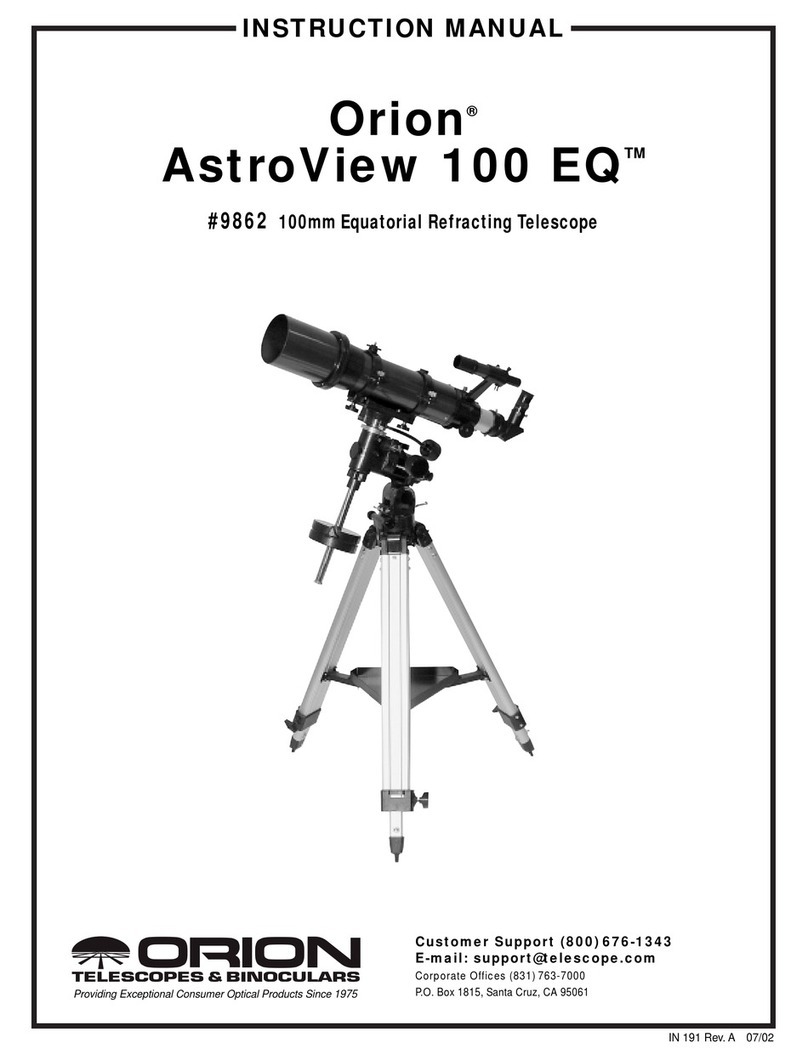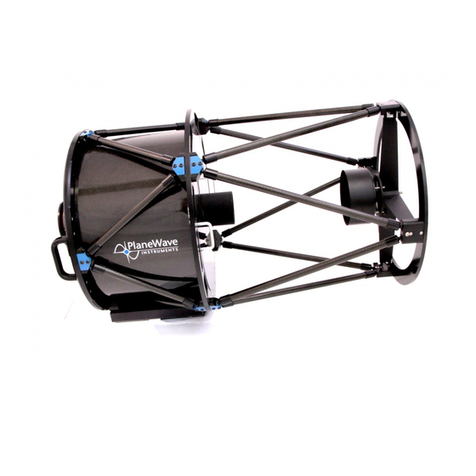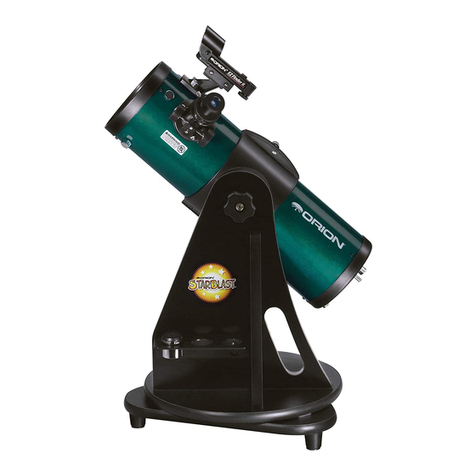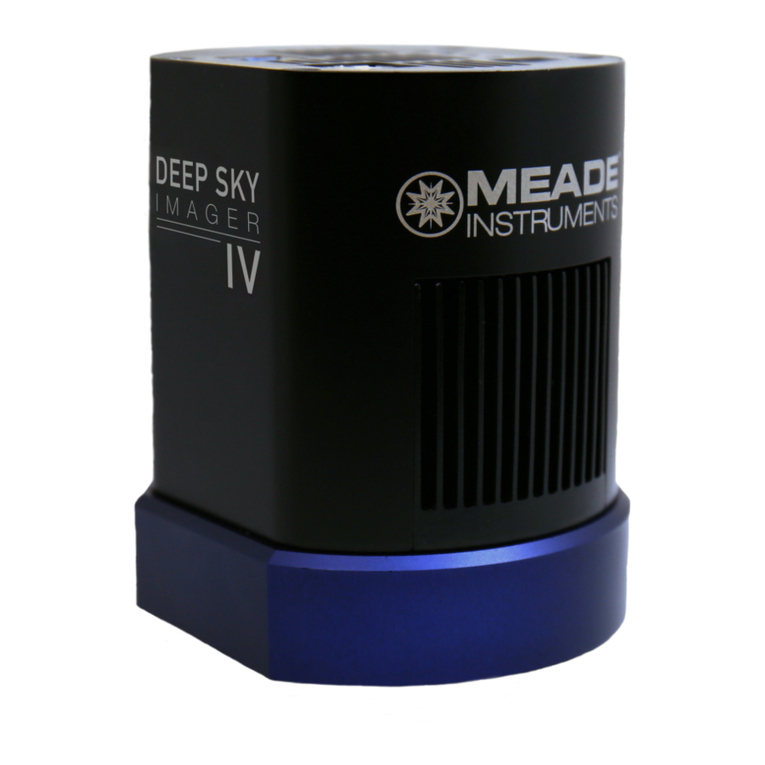Citiwell NG76AZ User manual

114AZ Telescope
Instructions
and
Owner’s Manual

2
Colors of some components may vary from those shown in this manual.
WARNING!
NEVER aim your telescope at the sun or even close to the sun!
Instant and irreversible damage can occur,
including blindness!
Do not let children use any telescope without adult supervision.
A
. Yoke
B. Finder scope with bracket
C. Image erector
D. Eyepieces (2)
E. Eyepiece cases (2)
F. Tripod leg adjustment bolts (3)
G. Accessory tray
H. 3X Barlow lens
I. Vertical fine adjustment rod
J. Tripod leg attachment bolts and
wing nuts (3)
K. Accessory tray attachment screws
and wing nuts (3)
L. Optical tube assembly
M. Tripod legs (3)
K
Parts of your 114AZ Telescope:

3
Introduction
Congratulations on your purchase of a new telescope. With proper care and handling
of your telescope, you will enjoy the pleasure of looking at nature’s wondrous sights
through the eye of this instrument for many years.
This telescope has been designed to provide views of the moon’s craters, Jupiter’s
major moons, and Saturn’s rings, in addition to dozens of galaxies, star clusters, and
nebulae.
As a terrestrial (land) telescope, this instrument delivers great views of mountains,
valleys, and many other features of the world around us. You can also use your
telescope to study animals and landscapes at a distance. To obtain the best
performance from your telescope, please read this manual carefully and completely.
!
WARNING!
CHOKING HAZARD
Small parts. Not suitable for
children under 3 years.

4
ASSEMBLY
1) Carefully remove all parts from the cardboard cartons and lay them on a table or
on the floor in order to take an inventory of all the pieces. Keep your box for storage
or in case you ever need to ship your telescope.
2) Extend the legs, and lock each one at the desired height with the supplied tripod
adjustment knob (See Fig. 1).
(Fig. 1)
3) Connect all three tripod legs to the yoke with the supplied tripod leg attachment
bolts, washers, and wing nuts. Each leg has a hinged black metal flange located
halfway down its length. The legs should be positioned so that these hinged flanges
are facing the inside of the tripod. Note that there are two black plastic spacers inside
the top sections of each leg (See Fig. 2).
(Fig. 2)
4) Attach the accessory tray to the tripod by inserting an accessory tray screw
downward through each of the three small holes located near the edge of the
accessory tray. Lift up the black metal accessory tray bracket on one tripod leg so
that it is at a right angle to the leg. Push the accessory tray screw through the
accessory tray and then through the slot in the accessory tray bracket (See Fig. 3).
Place a washer, then a wing nut over the screw and tighten the wing nut finger tight.
Repeat for the other two legs (See Fig. 4).

5
(Fig. 3) (Fig. 4)
5) After the nuts and bolts have been firmly tightened, the telescope optical tube
assembly can be attached to the yoke. On each side of the optical tube there is a round
black metal washer. Each washer has a large screw (altitude locking screw) in the
center and a smaller screw near the outside edge. Loosen all the screws. Mount the
optical tube assembly in the yoke as shown in Fig. 5. Rotate each washer slowly while
gently attempting to tighten the small screw by turning it clockwise with a Phillips (+)
screwdriver. When the washer is correctly oriented the small screw will fit into a hole
beneath the washer. Tighten the small screw firmly. Tighten the two altitude locking
screws. Repeat for the other side. (Note: Some production models may have two small
screws on each side of the optical tube assembly. In this case, tighten both screws
firmly.)
(Fig. 5)
6) Locate the vertical fine adjustment rod. It is a chrome-plated metal rod about six
inches long. Insert the smooth end into the chromed holder located on the side of the
yoke (See Fig. 6). You may have to loosen the large plastic locking knob in order to
insert the chromed rod. Once the rod is inserted (with the end with the hole facing the
focusing assembly) tighten the large locking knob just enough to prevent the rod from
falling out. Locate the chromed post on the side of the telescope tube near the
focusing assembly.

6
Remove the screw from the post. Insert it through the hole in the end of the vertical
fine adjustment rod and into the post. Turn the screw clockwise until it is tight.
(Fig. 6)
7) Remove the finder scope (with attached bracket) from the box. Remove the two
knurled thumbscrews from the telescope main tube (See Fig. 7). Position the finder
scope bracket onto the telescope tube so that the holes in the base of the bracket
line up with the exposed holes in the telescope tube. Replace the two knurled
thumbscrews and tighten securely (See Fig. 8).
(Fig. 7) (Fig. 8)
Azimuth Locking Knob

7
8) Insert the 20-mm eyepiece into the eyepiece holder (See Fig. 9). Tighten the small
set screw to hold the eyepiece securely in place.
(Fig. 9)
11) A 3X Barlow lens is supplied to triple the basic magnifying power provided by an
eyepiece. In viewing situations where very high magnifying powers are desired, insert
the 3X Barlow lens between the eyepiece and the focusing tube (See Fig. 10).
(Fig. 10)
FINDER SCOPE ALIGNMENT
Since a telescope has a narrow field of view by design, it can be challenging to locate a
particular star or planet. For this reason the telescope is fitted with a low-power, wide-
field miniature telescope called a finder scope. Always use your finder scope to locate
the object you want to view FIRST. The finder scope should be aligned with the
main telescope tube before you begin using the telescope, in order that both
scopes are positioned to always provide exactly the same angle and view.
Note: Objects in the finder scope are upside down. This is normal and is common to all
astronomical telescopes.

8
Complete the following settings in daylight:
1) Insert the 20-mm eyepiece into the diagonal mirror. Look at an easily recognizable,
stationary object that is at least 300 feet away. Slightly loosen the two altitude control
locking knobs, the azimuth locking knob (See Fig. 2 on page 4), and the vertical fine
adjustment rod. Turn the telescope on both its horizontal and vertical axis until the
object is in the center of the field of view. Then bring the image into focus.
2) Firmly retighten the adjusting knobs and the vertical fine adjustment rod so that the
telescope is locked in position.
3) Look through the finder scope. If the object is not visible or centered in the finder
scope, simply release one of the three small adjusting screws holding the finder scope
and reposition the finder scope until the object is centered within the X-shaped
crosshairs.
4) All screws should be completely tightened as soon as the view through the finder
scope coincides with the view of the main telescope.
5) You may need to repeat this procedure to ensure a perfect alignment.
THE ALTAZIMUTH MOUNT
This telescope is fitted with an altazimuth mount. “Alt” refers to altitude, the vertical
movement of the telescope, while “azimuth” refers to the horizontal movement.
ABOUT MAGNIFICATION
The magnification power of a telescope indicates how much an image is enlarged or
how big and close it appears to the viewer. The focal length of the eyepiece, combined
with the focal length of the telescope, determines the magnification power. To calculate
the power of your telescope with any particular eyepiece, simply divide the focal length
of the telescope (900 mm) by the focal length of the eyepiece (indicated in “mm” on the
eyepiece collar).
Example: 900-mm focal length (tube) = 45X magnification power
20-mm focal length (eyepiece)
The following magnification values are achieved when using the Barlow lens and the
interchangeable eyepieces:
Eyepiece Power Power With 3X Barlow Lens
20 mm 45X 135X
4 mm 225X 675X

9
The level of magnification required depends on the object being observed. Optimal
performance is obtained if the magnification is typically not more than about 30X for
every 10 mm of objective lens diameter. Magnification of around 335X or less is ideal
for a telescope with a 114-mm diameter objective lens and is best for observing most
celestial objects. A lower magnification power and a wider field of view are advisable for
observing galaxies and nebulae. The highest magnification power should be used for
highly detailed observations of the moon, Jupiter and Saturn or any object that is quite
bright.
The highest magnification power of the Barlow lens/4-mm eyepiece combination should
only be used for large or bright objects such as the moon and the brightest planets.
ABOUT YOUR NEWTONIAN REFLECTOR TELESCOPE
Your telescope is a Newtonian reflector. Light enters the open end of the tube and
travels down to the opposite end where it strikes a specially curved mirror, known as the
primary mirror. The focused image is reflected back up the tube to a small, flat mirror
near the open tube end, called the secondary mirror. This secondary mirror reflects the
focused image out through the side of the telescope tube to the eyepiece holder where
it is enlarged for viewing through the eyepiece.
The primary mirror is a precision ground and polished
component that is precisely positioned at one end of the optical
tube. It is pre-aligned for maximum peformance at the factory
and should not need any adjustment. Therefore, never adjust
or remove any of the screws located at this end of the
optical tube. Doing so will void your warranty and degrade
the performance of your telescope (See Fig. 10a).
(Fig. 10a)
USING YOUR TELESCOPE
1) Take your telescope outside. Viewing objects through closed or open windows is not
recommended. Your view can be distorted by reflections in the glass of a closed
window or by air currents of differing temperatures passing through an open window.
2) Let your telescope adjust to the outside temperature. Your telescope will perform
much better if the temperature of the mirrors, eyepiece lenses, and the air inside the
tube are the same as the outside temperature. It may take up to 30 minutes to
equalize the temperatures when the difference in temperatures is extreme.
3) Find a location far from glaring light. If you live in an urban area, your viewing will
probably improve the farther you move away from the city lights. The sky glow of a
town or city can dramatically reduce the telescope’s performance and viewing
capabilities.
4) Remove the dust cap from the end of the telescope nearest the eyepiece holder and
the finder scope. The dust cap consists of two pieces — a small, removable center
piece and the large main cap (See Fig. 12). Both pieces should be removed (See
Fig. 13). The open end of the optical tube is pointed toward the subject you wish to
observe.

10
(Fig. 11) (Fig. 12)
5) Begin your viewing session by using the 20-mm eyepiece by itself. It will give you
the widest angle and the brightest, sharpest views. To adjust the angle of the
telescope, loosen the tightening screws on either side of the mounting yoke and the
azimuth locking knob (See Fig. 2 on page 4). If you wish to adjust the angle of the
telescope tube vertically in large increments, also loosen the tightening knob that
holds the vertical fine adjustment rod. For fine vertical motions, gradually tighten the
knurled knob on the vertical fine adjustment rod.
When possible, avoid sudden temperature changes, as the moisture in the air will
condense on the mirrors and eyepiece lenses. Should this occur after bringing your
telescope inside, remove the dust caps and allow the moisture to evaporate naturally.
Point the telescope downward to minimize the collection of airborne dust. Once all of
the moisture has evaporated, replace the dust caps.
A NOTE ON TERRESTRIAL VIEWING
You may notice that when you observe a terrestrial subject on land or water it appears
upside down.
To correct this, an image erector is included with your telescope. This accessory is
inserted in the eyepiece holder of the telescope between the eyepiece and the
telescope. With the image erector, objects will appear in their proper orientation for
terrestrial and land observation. NOTE: Do not use the 3X Barlow lens with this
accessory (See Fig. 13).

11
(Fig. 13)
The image erector provides 1.5X magnification, which means that the 20-mm eyepiece
will magnify objects from 45X to 68X when used in conjunction with the image erector.
CARE AND CLEANING OF OPTICS
Optical components of a telescope get dirty over time. Dirt or dust on a lens should be
removed with the utmost care. A considerable amount of dirt or dust would have to
accumulate on the optical surface before your view would be compromised.
1) Keeping dust caps on during storage and transport will reduce dust collection.
2) Condensation may collect on the optical surfaces when the telescope is not in use.
Remove the dust caps and allow the moisture to evaporate naturally. Point the
telescope downward to minimize the accumulation of airborne dust.
3) Once all moisture has evaporated, replace the dust caps.
4) Filtered, compressed air may be used to remove surface dust from lenses and
mirrors. Remove the dust cap and the dew shield. Once removed, point the can away
from the lens and gently expel some air and any condensation or dust that has
accumulated on the discharge tube. Spray the lens or mirror with short bursts of air to
carefully remove the dust particles. DO NOT HOLD THE TRIGGER OF THE
COMPRESSED AIR CAN FOR EXTENDED PERIODS BECAUSE PROPELLANT
FROM THE CAN MIGHT ESCAPE AND DAMAGE THE OPTICAL SURFACE.
If, after several attempts, you cannot remove the particles, take the telescope to an
optical professional for cleaning.
If you keep the dust caps on your telescope when it is not in use and avoid handling the
lenses or mirrors, only minimal optical maintenance of your telescope should be
required. Extensive cleaning is usually only necessary every few years.

12
WHAT TO LOOK FOR IN THE NIGHT SKY
There is a whole universe of objects you could view at night, so where do you start?
We recommend starting with the most prominent objects first.
The moon
The moon is the easiest target to find at night. When the moon is in full position, it
bathes the night with a silvery light that washes the sky of all but the brightest objects.
The best time to view the moon is not when it is full, but rather when it is less than half
full. The dividing line between dark and light on the moon, called the terminator, shows
the best detail in the craters and mountains.
The planets
The planets, our solar system companions, range in size and substance from moon-size
rocky bodies to giant gas balls, which could hold Earth 1,000 times over. To find the
planets, you will need information about their times of visibility. An astronomy magazine
will give you the locations of the planets as they change position from month to month.
The Internet is also an excellent source of information, offering star charts, maps, and
more!
The popular and more familiar constellations often provide the easiest landmarks to
help find the planet’s locations and paths of orbit. Most people have looked up at the
sky at night and seen some of the planets without even realizing it. A planet looks like a
bright star but does not twinkle like a star does; it looks like a tiny ball. Venus, Mars,
Jupiter, and Saturn are the easiest planets to view. Mercury is dimmer, usually below
the horizon, and more challenging to find.
Each of the planets provides interesting views. Venus is covered with clouds so all that
is visible is an extremely bright light, the brightest next to the moon. However, Venus,
like the moon, goes through phases. As it travels around the sun, different areas of its
surface are illuminated, producing crescent shapes of varying sizes. Mars is the red
planet. When it is above the horizon, it is noticeably red and stands out like a beacon in
the night sky. The apparent brightness of Mars varies as the planet orbits around the
sun and throughout its period of visiblity, it will look brighter or dimmer depending on its
distance from Earth.
Jupiter is the largest planet in our solar system and the second brightest next to Venus.
Jupiter has many moons, four of which are often visible through your telescope when
viewing conditions permit. As you watch them throughout the evening, you will see that
they change position relative to each other and to Jupiter. It is possible with careful
planning to actually see one of the moons disappear either in front of or behind Jupiter
as it orbits around the planet. Another great feature of Jupiter is its cloud belt.
Jupiter is alive with weather activity and its clouds have formed over time into belts
visible through telescopes in the right atmospheric conditions.

13
Saturn, the second largest planet, is not as bright as Jupiter and so its moons are not as
visible through small telescopes. The large rings that encircle Saturn are spectacular to
observe, however. The planet and its rings appear pale yellow. The major division in the
rings, the Cassini division, is possible to see if you keep the telescope firmly in position.
Uranus and Neptune are the last of the solar system’s gas giants. They do not provide
as spectacular a sight as Jupiter or Saturn, but are nonetheless rewarding to see.
Beyond our solar system there are many more objects to be found. Galaxies, nebulae,
and star clusters abound!
FREQUENTLY ASKED QUESTIONS
1) How far can I see?
If you stand outside and look up at the night sky on a clear evening, you can see
hundreds of stars without the aid of your telescope. The telescope is a light-gathering
instrument that magnifies the view — providing significantly more detail and unveiling
more stars, nebulae, and celestial objects. With the aid of a telescope, you will be able
to enjoy exciting views of Saturn’s rings, Jupiter’s major moons, the Orion Nebula, and
much more.
2) Why can’t I see anything through my telescope?
If you see only gray or black when looking through your telescope, even after searching
for an object to view, it is very likely that you are using an eyepiece that is too powerful.
To solve this problem always start with the lowest power eyepiece first, and only insert
the higher-power eyepiece after you have located an object.
3) When I use my high-power eyepiece, everything looks much darker. Why?
As magnification in a telescope increases, brightness diminishes. Conversely,
brightness increases when magnification is reduced. If an image appears too dark or
unclear, use a lower-powered eyepiece. Views of small, bright objects are superior to
those of large, dark, or blurry ones! Atmospheric conditions, air currents, as well as light
and air pollution also affect viewing quality.
4) As I look through my telescope, objects in the sky appear to move. Why is
that?
The constant rotation of the Earth makes things appear to move. Lower-power
eyepieces will reduce this effect of movement considerably and allow you to observe an
object for a longer duration before you have to readjust your telescope.

14
!
Made in China
Manual Part # 260388
WARNING! CHOKING HAZARD
–
Small parts. Not suitable for children
under 3 years.
Table of contents
Other Citiwell Telescope manuals
Popular Telescope manuals by other brands
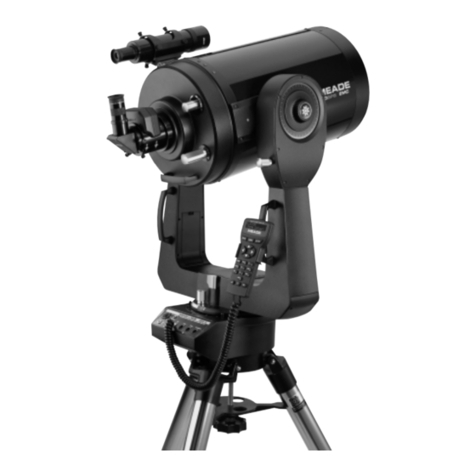
Meade
Meade LX200GPS instruction manual
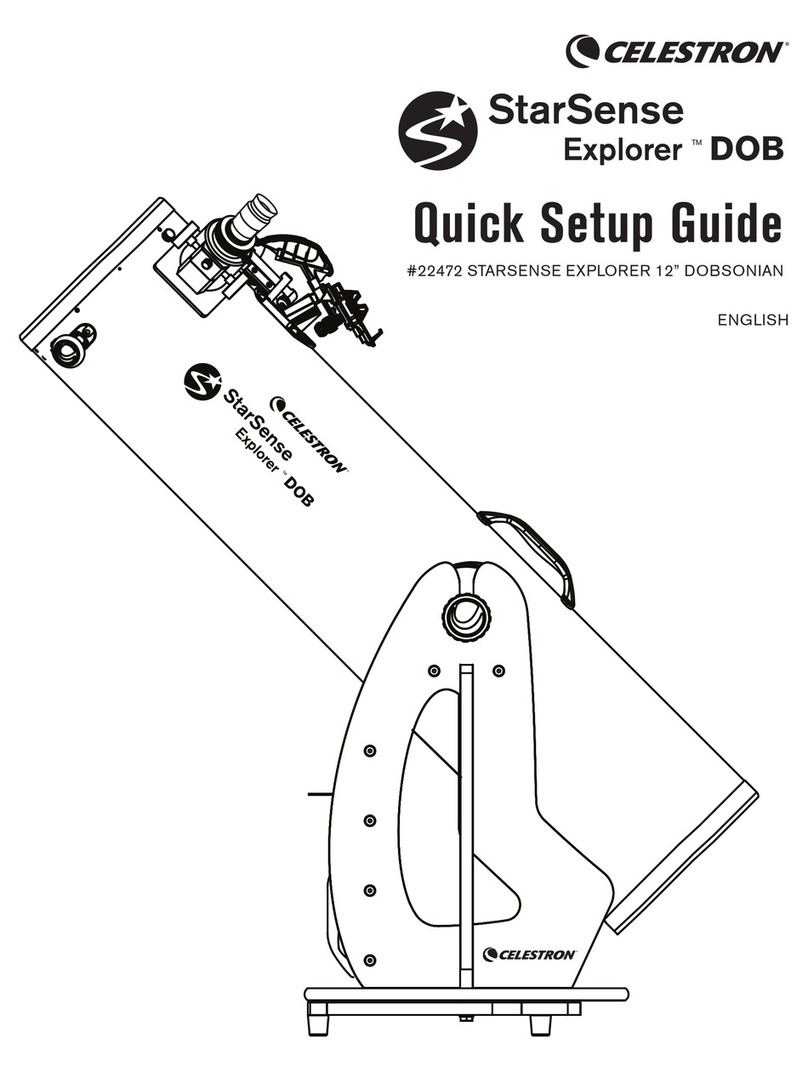
Celestron
Celestron StarSense Explorer DOB Quick setup guide
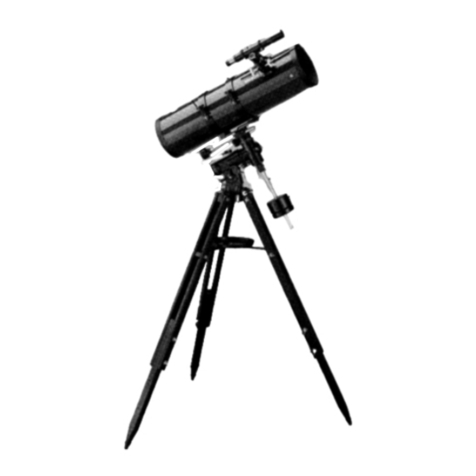
Meade
Meade 6600 operating instructions
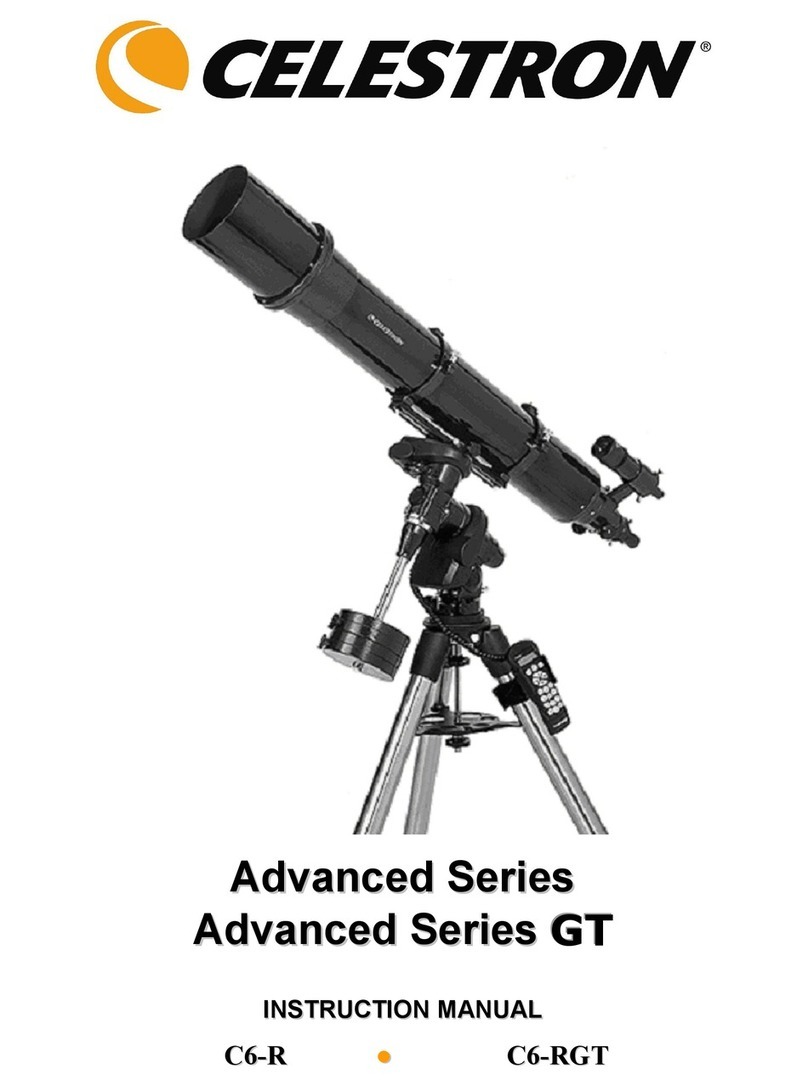
Celestron
Celestron Advanced Series C6-RGT instruction manual
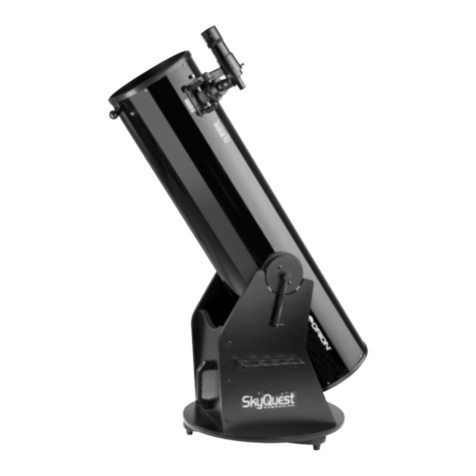
ORION TELESCOPES & BINOCULARS
ORION TELESCOPES & BINOCULARS SkyQuest XT10 9810 instruction manual
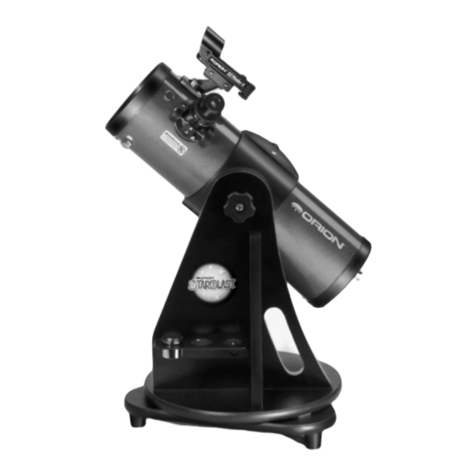
Orion
Orion starBlast 4.5 EQ instruction manual
